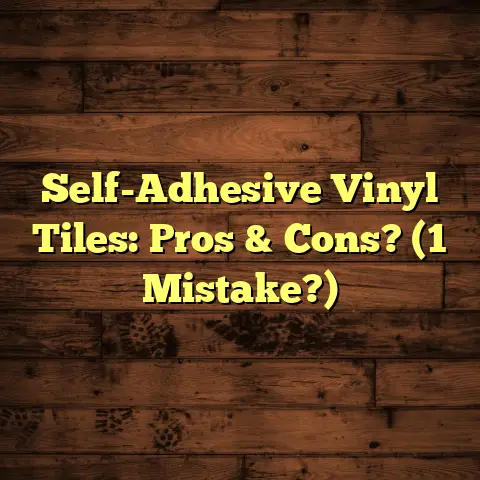Remove Paint From Laminate? (5 Pro-Approved Tips!)
(5 Pro-Approved Tips!)
Ever walked into a room, ready to admire the space, only to be smacked in the face by a glob of paint on the floor?Yeah, me too. As a flooring contractor for over 15 years, I’ve seen it all.
Paint happens. But when it lands on your beautiful laminate flooring, panic can set in fast. Don’t worry! You can fix this.
I’m here to walk you through five pro-approved tips to get that paint off your laminate and restore your floor to its former glory. Let’s dive in!
1. Understanding Laminate Flooring
So, first things first, let’s talk laminate. It’s become super popular, and for good reason.
It’s durable, looks great, and is often more affordable than hardwood. You’ll find it everywhere these days – living rooms, bedrooms, even kitchens!
But why does paint end up there in the first place? Well, think about it:
- DIY projects: We all love a good DIY project, but sometimes things get messy.
- Kids: Little artists can be enthusiastic, but not always precise.
- Professional painters: Even pros can have accidents (though hopefully less often!).
Whatever the reason, paint happens. The key is knowing how to deal with it.
2. Tip 1: Assess the Type of Paint
Okay, this is crucial. Not all paints are created equal. We’ve got two main contenders:
- Water-based paints: These are your acrylics, latex paints, and most interior wall paints. They’re generally easier to clean up.
- Oil-based paints: These are tougher, more durable, and often used for trim or cabinets. They require stronger solvents for removal.
Why does this matter? Because the type of paint dictates the best removal method.
Trying to scrub away oil-based paint with just water? Good luck! You’ll need something stronger.
How to tell the difference?
Here’s a quick test:
- Warm, soapy water: Try cleaning a small, inconspicuous area with warm water and dish soap. If the paint starts to soften and lift, it’s likely water-based.
- Rubbing alcohol: Dab a cotton ball with rubbing alcohol and gently rub it on the paint. If the paint transfers to the cotton ball, it’s probably water-based.
- Smell test: Oil-based paints often have a distinct, stronger odor than water-based paints.
Knowing your enemy is half the battle!
3. Tip 2: Gather the Right Tools and Materials
Alright, time to gear up! Here’s what I usually keep on hand for paint removal from laminate:
- Plastic Scrapers: These are your best friends. Never use metal scrapers – they’ll scratch the laminate. I recommend a variety of sizes.
- Soft Cloths/Microfiber Towels: For wiping and blotting.
- Warm Water: Essential for softening water-based paints.
- Dish Soap: A mild detergent to help lift the paint.
- Rubbing Alcohol (Isopropyl Alcohol): Great for water-based paints and general cleaning.
- Vinegar: Another natural option for softening paint.
- Denatured Alcohol or Paint Thinner (for oil-based paints): Use with extreme caution (more on that later).
- Cotton Balls/Swabs: For precise application of solvents.
- Safety Glasses: Protect your eyes!
- Gloves: Protect your hands from chemicals and paint.
- Old Toothbrush: For scrubbing textured areas.
Why these tools?
Each tool serves a specific purpose. The plastic scraper gently lifts the paint, the cloths wipe away residue, and the solvents break down the paint’s bond.
Where to source these materials affordably?
Check your local hardware store, home improvement center, or even your kitchen cabinets! Many of these items you probably already have.
4. Tip 3: The Power of Solvents
Okay, let’s talk solvents. These are the heavy hitters when it comes to paint removal, especially for oil-based paints. But remember, safety first!
Here’s a breakdown:
- Rubbing Alcohol (Isopropyl Alcohol): A good starting point for water-based paints. It’s relatively mild and safe for laminate.
- Denatured Alcohol: Stronger than rubbing alcohol and effective on some oil-based paints.
- Acetone (Nail Polish Remover): A powerful solvent that can dissolve many types of paint. Use with extreme caution, as it can damage some laminate finishes.
- Paint Thinner (Mineral Spirits): The strongest option, primarily for oil-based paints. Use it sparingly and with excellent ventilation.
Step-by-step guide to safely applying solvents:
- Ventilation: Open windows and doors to ensure good airflow.
- Protection: Wear safety glasses and gloves.
- Test Spot: Always test the solvent on an inconspicuous area of the laminate first to check for discoloration or damage.
- Application: Dip a cotton ball or swab into the solvent and gently dab it onto the paint spot. Let it sit for a minute or two to soften the paint.
- Wipe and Scrape: Use a soft cloth to wipe away the softened paint. If needed, gently scrape with a plastic scraper.
- Repeat: Repeat steps 4 and 5 until the paint is removed.
- Clean Up: Wipe the area with a clean, damp cloth to remove any solvent residue.
Precautions:
- Never pour solvents directly onto the laminate.
- Avoid prolonged exposure to solvents, as they can damage the finish.
- Keep solvents away from heat, sparks, and open flames.
- Dispose of used cloths and solvents properly. Check your local regulations.
Real-life example:
I once had a client who accidentally spilled a can of oil-based paint all over their brand-new laminate floor. Panic city! I carefully used paint thinner, following the steps above, and managed to remove all the paint without damaging the floor. The key was patience and testing in an inconspicuous area first!
5. Tip 4: Gentle Scraping Techniques
Alright, let’s talk scraping. This is where finesse comes in. Remember, the goal is to remove the paint, not the laminate finish!
Why plastic scrapers?
Metal scrapers are a big no-no. They’re too abrasive and will almost certainly scratch the laminate. Plastic scrapers are much gentler and more forgiving.
Detailed instructions on how to angle and apply pressure:
- Angle: Hold the plastic scraper at a shallow angle (around 30-45 degrees) to the laminate surface.
- Pressure: Apply gentle, even pressure. Don’t force it! Let the scraper do the work.
- Direction: Scrape in the direction of the laminate grain, if visible. This helps to avoid scratching.
- Overlap: Overlap your scraping strokes slightly to ensure you remove all the paint.
Tips for tackling stubborn paint spots:
- Soften first: Apply a solvent or natural remedy (more on that next!) to soften the paint before scraping.
- Multiple passes: Instead of trying to remove all the paint in one go, make multiple gentle passes.
- Warm it up: Use a hairdryer on a low setting to gently warm the paint. This can help to soften it.
- Patience: Don’t get frustrated! Stubborn paint spots may take time and effort to remove.
Personalized storytelling:
I remember one time, I was removing paint from a laminate floor in an old Victorian house. The paint was ancient and rock-hard. I spent hours gently scraping away at it, one tiny piece at a time. It was tedious, but the end result was worth it! The floor looked amazing, and the client was thrilled.
6. Tip 5: Natural Remedies for Paint Removal
If you’re concerned about harsh chemicals, or just prefer a more eco-friendly approach, natural remedies are a great option. Here are a few of my favorites:
- Vinegar and Baking Soda: This is a classic combination for a reason. The vinegar helps to soften the paint, while the baking soda acts as a gentle abrasive.
- Essential Oils (Lemon or Orange): Citrus oils are natural solvents that can help to dissolve paint.
- Mayonnaise: Yes, you read that right! Mayonnaise contains oils that can help to break down the paint’s bond.
Step-by-step guide to each natural remedy:
Vinegar and Baking Soda:
- Preparation: Mix equal parts vinegar and baking soda into a paste.
- Application: Apply the paste to the paint spot and let it sit for 15-20 minutes.
- Scrub and Wipe: Gently scrub the area with a soft cloth or old toothbrush. Wipe away the residue with a clean, damp cloth.
Essential Oils:
- Application: Apply a few drops of lemon or orange essential oil directly to the paint spot.
- Let it Sit: Let it sit for 5-10 minutes.
- Wipe and Scrape: Wipe away the softened paint with a soft cloth. If needed, gently scrape with a plastic scraper.
Mayonnaise:
- Application: Apply a generous amount of mayonnaise to the paint spot.
- Let it Sit: Let it sit for several hours or overnight.
- Wipe and Scrape: Wipe away the softened paint with a soft cloth. If needed, gently scrape with a plastic scraper.
Advantages of using natural methods:
- Eco-friendly: They’re made from natural ingredients and won’t harm the environment.
- Safer: They’re less likely to cause skin irritation or respiratory problems.
- Gentle: They’re less likely to damage the laminate finish.
Unique insights:
I’ve found that the mayonnaise trick works particularly well on dried, stubborn paint spots. The oils in the mayonnaise really penetrate the paint and help to break it down. It might sound weird, but trust me, it works!
Conclusion: Restoring Your Laminate Floors to
Their Former Glory
So, there you have it! Five pro-approved tips for removing paint from laminate flooring.
Remember, the key is to act promptly, assess the type of paint, gather the right tools, and use gentle techniques.
And most importantly, always test any solvent or remedy on an inconspicuous area first.
There’s nothing like the satisfaction of successfully removing paint without damaging your beautiful laminate floor. It’s like giving your room a fresh start!
Now, go forth and conquer those paint splatters! And don’t forget to share your experiences and results in the comments below. I’d love to hear how these tips worked for you.





